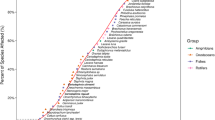Abstract
Effects of chlorpyrifos and cypermethrin on the survival, growth and emergence of Chironomus riparius were determined on a life-cycle study. Although neither cypermethrin nor chlorpyrifos affected larval survival or growth, a decrease in the number of emerged midges and in the number of females over males, as well as in female biomass, were found for both insecticides. The results from this study indicate that multiple biological endpoints and extended periods of exposure are needed in order to achieve a better screening of insecticide toxicity.
Similar content being viewed by others
References
Amweg EL, Weston DP, Ureda NM (2005) Use and toxicity of pyrethroid pesticides in the Central Valley, California, USA. Environ Toxicol Chem 24:966–972. doi:10.1897/04-146R1.1
ASTM (2000) Standard test methods for measuring the toxicity of sediment-associated contaminants with freshwater invertebrates (E 1706). In: Annual Book of ASTM standards, vol 11.05, Philadelphia
CDFG (1994) Hazard assessment of the insecticide chlorpyrifos in the Sacramento-San Joaquim River system (94-1). Environmental Services Division, California
Crane M, Attwood C, Sheahan D, Morris S (1999) Toxicity and bioavailability of the insecticide pirimiphos methyl to the freshwater amphipod Gammarus pulex L. in laboratory and mesocosms systems. Environ Toxicol Chem 18:1456–1461. doi:10.1897/1551-5028(1999)018<1456:TABOTO>2.3.CO;2
Curtis JE, Horne PA (1995) Effect of Chlorpyrifos and Cypermethrin Applications on Nontarget Invertebrates in a Conservation-Tillage Crop. J Aust Entomol Soc 34:229–231. doi:10.1111/j.1440-6055.1995.tb01327.x
Faria MF, Ré A, Malcato J, Silva P, Pestana J, Agra AR, Nogueira AJA, Soares AMVM (2006) Biological and functional responses of in situ bioassays with Chironomus riparius larvae to assess river water quality and contamination. Sci Total Environ 371:125–137. doi:10.1016/j.scitotenv.2006.08.036
Fernández-Gutiérrez A, Martínez-Vidal JL, Arrebola-Liébanas FJ, Gonzalez-Casado A, Vílchez JL (1998) Determination of endosulfan and some pyrethroids in waters by micro liquid extraction and GC-MS. Fresenius J Anal Chem 360:568–572. doi:10.1007/s002160050760
Ingersoll CG, Ankley GT, Benoit DA, Brunson EL, Burton GA Jr, Dwyer FJ, Hoke RA, Landrum PF, Norbergking TJ, Winger PV (1995) Toxicity and bioaccumulation of sediment-associated contaminants using freshwater invertebrates. Environ Toxicol Chem 14:1885–1894. doi:10.1897/1552-8618(1995)14[1885:TABOSC]2.0.CO;2
Linders JBHJ, Jansma JW, Mensink BJWG, Ottermann K (2002) Pesticides: benefaction or pandora’s box? National Institute of Public Health and Environmental Protection, The Netherlands
Meregalli G, Pluymers L, Ollevier F (2001) Induction of mouthpart deformities in Chironomus riparius larvae exposed to 4-n-nonylphenol. Environ Pollut 111:241–246. doi:10.1016/S0269-7491(00)00068-3
OECD (2001) Guidelines for testing of chemicals—Guideline 219. Sediment-water chironomid toxicity test using spiked water, Draft Document. Organisation for Economic Co-operation and Development, Paris, 21
Péry ARR, Mons R, Flammarion P, Lagadic L, Garric J (2002) Modeling approach to link food availability, growth, emergence, and reproduction for the midge Chironomus riparius. Environ Toxicol Chem 21:2507–2513. doi:10.1897/1551-5028(2002)021<2507:AMATLF>2.0.CO;2
Relya RA (2005) The impact of insecticides and herbicides on the biodiversity and productivity of aquatic communities. Ecol Appl 15:618–627. doi:10.1890/03-5342
Sibley PK, Monson PD, Ankley GT (1997) The effect of gut contents on dry weight estimates of Chironomus tentans larvae: implications for interpreting toxicity in freshwater sediment toxicity tests. Environ Toxicol Chem 16:1721–1726. doi:10.1897/1551-5028(1997)016<1721:TEOGCO>2.3.CO;2
Sibley PK, Ankley GT, Benoit DA (2001) Factors affecting reproduction and the importance of adult size on reproductive output of the midge Chironomus tentans. Environ Toxicol Chem 20:1296–1303. doi:10.1897/1551-5028(2001)020<1296:FARATI>2.0.CO;2
Stephenson RR (1982) Aquatic toxicology of cypermethrin. Aquat Toxicol 2:175–185. doi:10.1016/0166-445X(82)90014-5
Acknowledgments
The authors acknowledge ‘‘Fundacão para a Ciência e Tecnologia” (FCT) for its financial support to Ana Raquel Agra, in a form of a masters’ grant (SFRH/BM/8402/2002). This work was partially funded by FCT Project reference PTDC/BIA-BDE/72841/2006. The authors thank Abel Ferreira for assistance in the laboratory.
Author information
Authors and Affiliations
Corresponding author
Rights and permissions
About this article
Cite this article
Agra, A.R., Soares, A.M.V.M. Effects of Two Insecticides on Survival, Growth and Emergence of Chironomus riparius Meigen. Bull Environ Contam Toxicol 82, 501–504 (2009). https://doi.org/10.1007/s00128-009-9658-z
Received:
Accepted:
Published:
Issue Date:
DOI: https://doi.org/10.1007/s00128-009-9658-z




